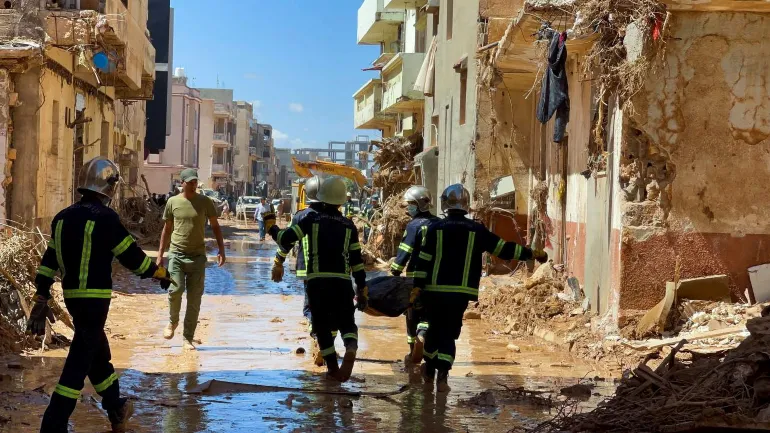Flooding Death Toll Jumps To 11,300 In Libya’s Coastal City Of Derna

The death toll in Libya’s coastal city of Derna has soared to 11,300 as search efforts continue following a massive flood fed by the breaching of two dams in heavy rains, the Libyan Red Crescent said.
Marie el-Drese, the International Federation of Red Cross and Red Crescent Societies (IFRC) Libya secretary-general, told The Associated Press news agency another 10,100 people are reported missing in the Mediterranean city.
Health authorities previously put the death toll in Derna at 5,500. The storm also killed about 170 people elsewhere in the country.
The mayor of Derna, Abdel-Moneim al-Ghaithi, said the tally could climb to 20,000 given the number of neighborhoods that were washed out.
The flooding swept away entire families in Derna on Sunday night and exposed vulnerabilities in the oil-rich country that has been mired in conflict since a 2011 uprising that toppled long-ruling dictator Muammar Gaddafi.
“Within seconds the water level suddenly rose,” recounted one injured survivor who said he was swept away with his mother in the late-night ordeal before they both managed to scramble into an empty building downstream.
“The water was rising with us until we got to the fourth floor,” the unidentified man said from his hospital bed, in testimony published by the Benghazi Medical Center.
“We could hear screams. From the window, I saw cars and bodies being carried away by the water. It lasted an hour or an hour and a half – but for us, it felt like a year.”
Tariq al-Kharaz, an interior ministry spokesman, put the number of deaths in Derna far lower at more than 3,000.
“The catastrophe is massive and as a result access to many areas is not possible. Many areas suffered total damage. Many dead bodies are still under the debris, others washed away into the sea,” al-Kharaz told the media
The storm also killed about 170 people in other parts of eastern Libya, including the towns of Bayda, Susa, Um Razaz and Marj, Health Minister Othman Abduljalil said.
Emergency workers sifting through the mud and rubble are still hopeful of finding survivors, IFRC said on Friday.
“The hope is there, is always there, to find people alive,” said Tamer Ramadan, head of the group’s rescue effort in the North African country.
Derna has begun burying its dead, mostly in mass graves, said Abduljalil.
More than 3,000 bodies were buried by Thursday morning while another 2,000 were still being processed. Most of the dead were buried in mass graves outside Derna, while others were transferred to nearby towns and cities.
Abduljalil said rescue teams are still searching wrecked buildings in the city centre, and divers are combing the sea off Derna.
Untold numbers could be buried under drifts of mud and debris, including overturned cars and chunks of concrete that rise up to 4 metres (13 feet) high. Rescuers have struggled to bring in heavy equipment as the floods washed out or blocked roads leading to the area.
“This disaster was violent and brutal,” said Yann Fridez, head of the Libya delegation of the International Committee of the Red Cross (ICRC), which had a team in Derna when the floodwaters hit.
“A wave 7 metres [23 feet] high wiped out buildings and washed infrastructure into the sea. Now family members are missing, dead bodies are washing back up on shore, and homes are destroyed.”
ICRC is distributing 6,000 body bags to help authorities and the Libyan Red Crescent Society “ensure dignified treatment of the dead”.
The World Health Organization and other aid groups on Friday called on authorities in Libya to stop burying flood victims in mass graves.
“We urge authorities in communities touched by tragedy to not rush forward with mass burials or mass cremations,” said Dr Kazunobu Kojima, medical officer for biosafety and biosecurity.
Poor maintenance, bad infrastructure
Access to Derna remains severely hampered as roads and bridges have been destroyed and power and phone lines cut to wide areas, where at least 30,000 people are now homeless.
The United Nations said, “with the collapse of most roads, the municipality [of Derna] is urging relevant authorities to establish a sea corridor for emergency relief and evacuations”.
The UN’s World Meteorological Organization chief Petteri Taalas said many deaths could have been avoided if early warning and emergency management systems had functioned properly in the war-scarred country.
With better coordination, “they could have issued the warnings and the emergency management forces would have been able to carry out the evacuation of the people, and we could have avoided most of the human casualties,” said Taalas.
Earlier this week, Derna’s Deputy Mayor Ahmed Madroud told Al Jazeera the dams had not been properly maintained since 2002.
Anas El Gomati, founder and director of the Sadeq Institute, blamed the eastern authorities for neglecting the city’s critical infrastructure and maintenance.
“Corruption and financial mismanagement are the cause behind failing infrastructure that has plagued Libya for decades,” he said.
“But the successive regimes are culpable, and it is the military investment authority that has cannibalised Libya’s public infrastructure in the east, destroying it to be smuggled and sold for scrap metal.”





